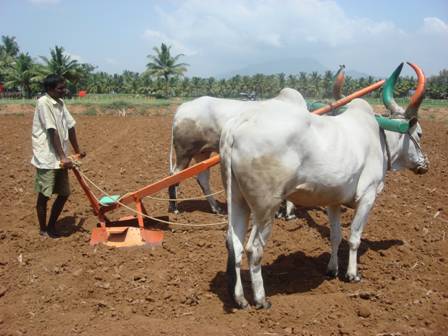
BULLOCK DRAWN IMPLEMENTS
Share
INTRODUCTION
Male cattle, called bullocks or oxen, are trained and used for pulling carts, plowing fields, and transportation, especially in traditional farming in developing countries. They are castrated for easier handling and are recognized for their stamina and muscle power, making them valuable for sustained physical work in agriculture. In many societies, bullocks are respected symbols of hard work and prosperity and are typically harnessed in pairs for efficiency. They need a diet rich in roughage, like hay and straw, for their maintenance. Despite the advancement of mechanized farming, they are still essential for small-scale farmers due to their cost effectiveness and reliability.
Traditional agricultural tools such as bullock-drawn implements have played a vital role in agricultural practices in rural areas. These tools, which include the plow for primary tillage, the disc harrow for soil clod fragmentation and ground leveling, seed drills for uniform seed planting, cultivators for secondary tillage, weeders for weed removal, ridgers for creating ridges, and levellers for field evenness, have proven to be essential for efficient agricultural practices.
In addition to their functionality, these tools offer cost-effective benefits with lower initial investment and maintenance requirements compared to mechanized equipment, making them accessible to small-scale farmers. Furthermore, they promote environmental sustainability by relying on animal power rather than fossil fuels, thus reducing carbon footprint. Additionally, these tools play a role in preserving traditional farming practices and cultural heritage by passing down valuable agricultural knowledge through generations.
However, it is important to note that these traditional tools are labor-intensive and less efficient compared to modern machinery, requiring substantial manual effort and skill in handling oxen.

TYPES OF IMPLEMENTS
Various bullock-drawn tools are utilized for diverse agricultural functions crucial in traditional and small-scale farming.
The following are typical varieties:
Plow (Plough):
Mouldboard Plow: Inverts the topsoil layer, facilitating the infusion of fresh nutrients while submerging weeds and crop remnants.
Disc Plow: Effortlessly cuts through soil and weeds, particularly effective in compact or stony terrain.
Harrow:
Disc Harrow: Disintegrates soil clumps and evens out the soil surface subsequent to plowing.
Spike Tooth Harrow: Levels the soil, contributing to weed suppression and soil aeration.
Seed Drill:
The apparatus places seeds at consistent depth and intervals, ensuring improved germination rates and optimal land utilization.
Cultivator:
This tool loosens soil and eliminates weeds amidst crop rows, enhancing soil aeration and fertility.

Weeder:
It is specially crafted to eradicate weeds without causing harm to the crops, thereby preserving the crop’s well-being and productivity.
Ridger:
Serves to create elevated land formations for the purpose of planting certain crops such as potatoes, contributing to the preservation of soil and the facilitation of irrigation.
Leveller:
Functions to even out the surface of the agricultural land subsequent to plowing or harrowing, thereby guaranteeing uniform distribution of water and nutrients.
Seed Cum Fertilizer Drill:
Simultaneously undertakes the task of sowing seeds and administering fertilizer, consequently ensuring accurate placement and efficient utilization of resources.
Reaper:
Deployed for the purpose of gathering mature crops by effectively severing them from the ground.
Thresher:
Engaged in the process of separating grain from the surrounding stalks and husks, thereby assisting in the subsequent stages of post-harvest processing.
Planter:
Employed to arrange seeds in rows with precision, thus securing appropriate spacing and depth for their growth.
Hoe:
Utilized for tasks involving the removal of weeds, formation of the soil, and the elimination of residual plant matter.
Cart:
Utilized for the transportation of various materials, including harvested crops, manure, and other agricultural resources.
Water Lifter:
Utilizes animal power to raise water for the purpose of irrigation, particularly in areas where modern pumps are not readily accessible.

BENEFITS & CHALLENGES
Advantages of Implements Pulled by Bullocks
Cost-Efficiency: Inferior initial outlay and maintenance expenses in contrast to mechanized machinery.
Availability: Suitable for small-scale farmers and areas with restricted access to contemporary equipment.
Environmentally Friendly: Decreased dependence on fossil fuels and diminished carbon emissions.
Cultural Importance: Upholds traditional farming methods and wisdom.
Challenges and Considerations
Efficiency: Slower and less efficient compared to modern tractors and implements.
Labor-Intensive: Requires more manual labor and can be physically demanding.
Training: Farmers need to be skilled in handling bullocks and maintaining the implements.
CONCLUSON
Traditional and small-scale agriculture heavily relies on bullock-drawn implements, encompassing plows, harrows, seed drills, and cultivators, as they are fundamental for executing crucial agricultural activities such as soil preparation, planting, weed control, and harvesting. Despite their lower efficiency compared to modern machinery, they offer costeffective and environmentally sustainable solutions, serving to uphold cultural heritage and foster sustainable farming practices. Ongoing enhancements have bolstered their efficacy and user-friendliness, thus rendering them more attainable for farmers. In essence, these implements assume a pivotal role in upholding food security and advancing sustainable agriculture, particularly in regions where access to mechanized equipment is limited.
FAQ
What are bullock-drawn implements and why are they utilized?
Bullock-drawn implements are traditional agricultural tools specifically designed to be harnessed and pulled by oxen. They are employed for a diverse range of farming activities such as plowing, seeding, and harvesting, particularly in areas where the adoption of mechanized farming is scarce or financially impractical.
What are some prevalent variants of bullock-drawn implements?
Typical examples consist of plows (both mouldboard and disc varieties), harrows (comprising disc and spike tooth types), seed drills, cultivators, weeders, ridgers, levellers, and carts. Each variant is tailored to fulfill a distinct agricultural function, encompassing soil preparation, sowing, and weed management.
What is the comparison between bullock-drawn implements and modern mechanized equipment?
Although bullock-drawn implements are less efficient and require more labor compared to modern machinery, they are more cost-effective and environmentally friendly. Additionally, they are accessible to small-scale farmers, aid in preserving traditional farming methods, and lessen reliance on fossil fuels.
What are the contemporary modifications made to bullock-drawn implements?
Recent adaptations consist of enhanced ergonomic structures, versatile tools, and the utilization of superior materials to improve productivity and usability. Furthermore, local manufacturing initiatives have rendered these implements more economical and customized to meet specific regional agricultural requirements.
